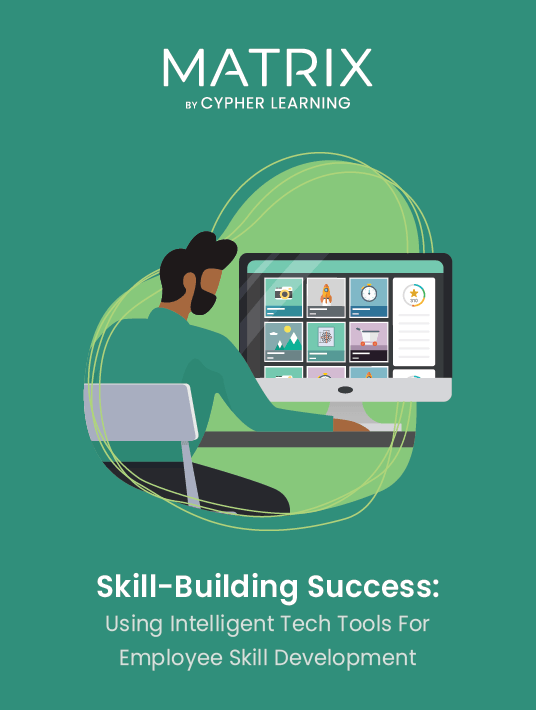Which Skills Development Strategies Build Practical Experience?
Skill training strategies are effective programs that provide a personalized learning experience based on your employees’ job title, learning goals, and competency levels. A great advantage that they bring is the fact that they can take place even during remote/hybrid training. Employees can go through the training program at their own pace, whenever their schedule allows, and ask for assistance when needed.
Let’s have a look at some ways you can maximize training potential through skill development activities.

eBook Release
Skill-Building Success: Using Intelligent Tech Tools For Employee Skill Development
Let’s explore how to design effective skills development strategies in any organization with the help of the latest learning technologies!
4 Skills Training Strategies
1. Offer Just-In-Time Resources
Employees prefer companies that make training and skill development a priority, as they appreciate learning on the job. No matter if they complete training in an office or at home, they like to have access to all the resources they need to learn so they can solve a real-world problem.
For example, if an employee needs to prepare a document and send it to a specific customer, they can easily learn how to address them by searching for a specific keyword in the training platform. Alternatively, they can learn that information by getting an automation learning suggestion based on their skill gaps. They learn how to write an email through a micro-course on “how to work with clients.”
This also teaches them how to act in similar situations. Next time they need to learn how to complete a task like that or one of their colleagues needs assistance, they’ll know to point them in the right direction. This is good as it saves time, reduces the possibility of making costly mistakes, and ensures everyone is on the same page regarding their training.
2. Create Scenario-Based Learning
No matter if your company creates training resources in-house or you facilitate them using an external provider, there are many opportunities to create resources based on your employees’ preferences and needs.
With scenario-based training, you can easily immerse your employees in a subject matter and provide them with the right resources so you can engage them in training. For example, you can create a course on how to steer the client in the right direction. It can include relevant examples on how to address this situation as well as pointers on how to complete this task successfully.
After taking the course, your employees will be able to use the problem-based learning approach whenever they need to solve an issue prevalent in their work.
3. Create Practical Learning Experiences
By creating scenario-based learning [1], you can use practical life scenarios for training. These can take place either online or offline. Additionally, by hosting workshops, you can focus on the practical part and leave the theory for asynchronous courses. This will bring great results as employees are not keen on sitting through a theory-heavy lecture.
This is a perfect time for your employees to practice their skills. For example, if they are taking a course on Workplace Resilience, they could film themselves in a certain setting or give some ideas on the topic and upload them to the platform. Later, their instructor and colleagues can leave feedback and suggestions.
4. Enable Project-Based Assessment Methods
Your learning platform is your go-to place for effective assessment methods such as quizzes, surveys, essays, and many more. All you need to do is create the assessment, let your employees know about it, and check the results.
However, it is also a good idea to pick collaborative and project-based assessments as they allow employees to work on real projects while interacting with one another.
For example, you can set up a course based on the skills your employees need to master. It can include training materials, assessments, as well as groups. This allows employees to exchange resources and ideas and get motivated to learn while completing tasks.
Once done, the projects can be achieved and re-used as many times as needed in the future. If they are looking for a way to upskill or demonstrate skill mastery [2] in the future, they can simply use those saved projects.
Key Takeaways
These are just a few activities that impart real-world experience to your employees. Most of them can be easily completed with the help of a learning platform. They don’t only take your training program to the next level but also provide a nice learning experience that is easy to complete no matter where training takes place.
Download the eBook Skill-Building Success: Using Intelligent Tech Tools For Employee Skill Development to learn how you can use modern technology to fuel employee growth. You can also join the webinar to discover how to create effective skill development programs for employees.
References
[1] 5 Effective And Impactful Examples Of Scenario-Based Learning
[2] How to Build a Successful Upskilling Program



















